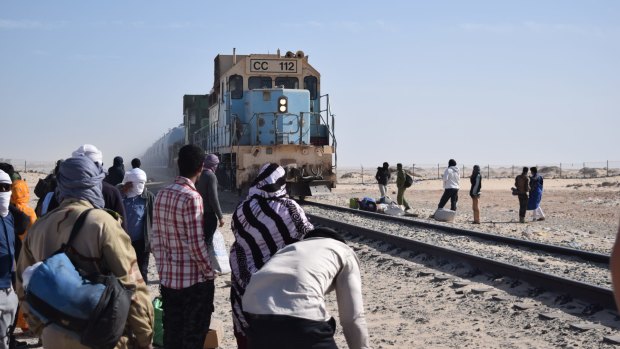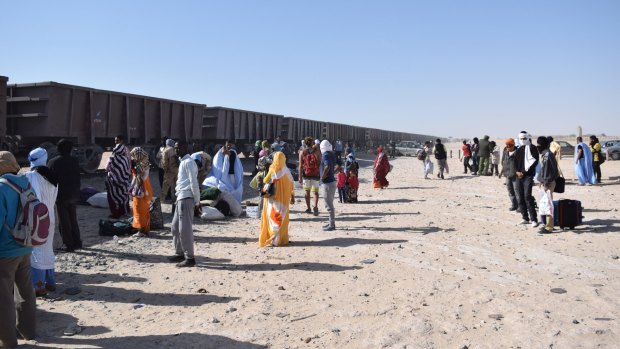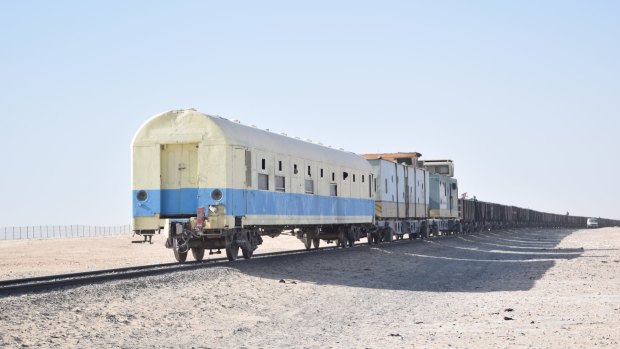This was published 6 years ago
Mauritania, Africa: Riding the iron ore train
By Hugh Carveth

If there is any reason to come to Mauritania's second-largest city, it is to ride on the iron ore train.Credit: Hugh Carveth
Nouadhibou, Mauritania's second-largest city, has few attractions. Surrounded by land mines and low-rise mud huts, it's dusty and basic. The road and the desert are one in Nouadhibou, which is also home to the world's biggest ship graveyard, where former grand citizens of oceanic accomplishment come to die. Marooned off the coast are dozens of hollowed hulls, decaying, sinking and drifting towards shore.
However, if there is any reason to come to Nouadhibou, it is to ride on the iron ore train.
Regarded as one of the world's longest trains, some 200 empty freight carriages screech into Nouadhibou's desert station every day. The train makes its way out through the distant Sahara, fills up with iron ore, and returns the next day. Jumping aboard the sole passenger carriage attached reluctantly to the rear, few tourists make the journey on this train.

Passengers wait to board the train.Credit: Hugh Carveth
The train's arrival time is simply "not before 3 o'clock", and well beforehand the locals start to jostle for position along the railway track. The iron ore carts are empty on this leg, so it is fair game to transport anything you can scramble aboard: cartons of food and water stacked metres high, goats and sheep, mattresses, containers, gas canisters, building supplies and other raw materials.
The train arrives relatively early, just after 4pm, a huge monolith of steel stirring up sand on the way through. With the train still moving at a steady pace, it's a scrum to get bodies and goods on board.
Imagine a European rail carriage from the 1970s, stripped of everything of any value: doors, glass, seats, cushioning, lights, toilet bowl. Take that skeleton of a train carriage, and add a layer of dust covering every surface. Then think of it being overcrowded to the point of danger, luggage and goods stacked ceiling-high in the corridors, holes in most exterior walls, a smell of pure filth, and finally, remove any illusion of comfort or cleanliness, and there you have the passenger carriage of the Mauritanian iron ore train.

Second-prize winner Hugh Carveth.Credit: Hugh Carveth
The novelty of my presence and the hospitality of my compartment neighbours makes for a pleasant trip and we share jokes and photos during the first few daylight hours of the journey. There is tea-making and prayer in the corridors, so you are confined to the compartment, the level of dust increasing as Saharan sand seeps through the holes and cracks of the ancient carriage.
Once night falls, the slow tilt of the train and brilliant desert night sky peering through the open windows are calming. However, the train is prone to violent and capricious braking. Being at the back of the train, when stopping you feel the full recoil of more than 200 carriages, enough to send bodies flying. Stopping is only half the trouble; once stationary you dread knowing that the train must start again shortly, with an equally forceful lurch.
Shortly before 5am, after 12 hours, the train slows in the town of Choum, where a handful of passengers and cargo are thrown off. This tiny village is where I will pick up an onward vehicle to Atar, the major city of the region. The train continues on to the mines and I travel the next leg of the journey in the back of a ute.

A passenger carriage brings up the rear of the immensely long freight train.Credit: Hugh Carveth
Seats inside the vehicle are quickly taken, and the luggage fills the trailer at the back. This leaves the youngest and fittest passengers, 12 in total, to climb onto the back of the truck, and hang on. The sun rises as the vehicle careers through the desert for almost three hours, the driver taking no care to ensure our safety at the vehicle's rear.
Several police checkpoints later, we arrived in Atar, where there is another vehicle to take me to Chinguetti, the World-Heritage-listed oasis town home to ancient Berber traders. Several days later I am still finding sand in all sorts of places.
Hugh Carveth, 27, is from Sydney. He has recently lived in Spain, Germany and Canada, and in 2016 travelled overland across Africa and Asia, some 30,000 kilometres using only public transport. He is now studying for a master's degree in international law at UNSW.
Sign up for the Traveller Deals newsletter
Get exclusive travel deals delivered straight to your inbox. Sign up now.